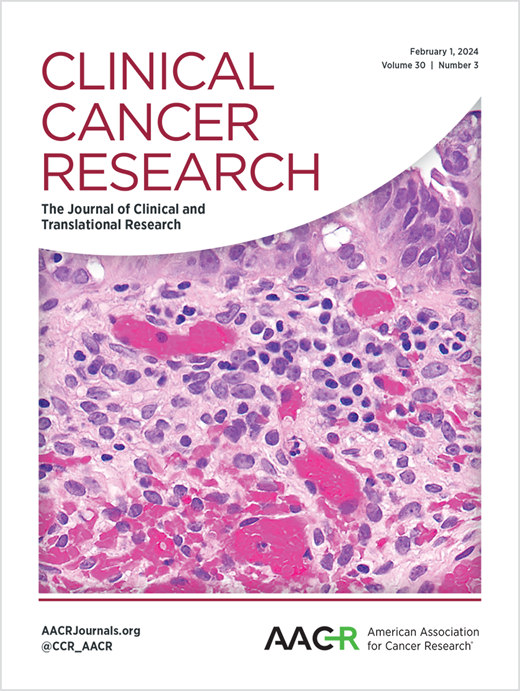Multiomics Profiling Distinguishes Sebaceous Carcinoma from Benign Sebaceous Neoplasms and Provides Insight into the Genetic Evolution of Sebaceous Carcinogenesis
IF 10
1区 医学
Q1 ONCOLOGY
引用次数: 0
Abstract
Purpose: Sebaceous carcinoma is the third most common nonkeratinocyte skin cancer in the United States with 1,000 cases per year. The clinicopathologic features of sebaceous carcinoma and benign sebaceous neoplasms (adenomas, sebaceomas) can overlap, highlighting the need for molecular biomarkers to improve classification. This study describes the genomic and transcriptomic landscape of sebaceous neoplasms in order to understand tumor etiology and biomarkers relevant for diagnosis and treatment. Experimental Design: We performed whole-genome sequencing (WGS) and whole-transcriptome sequencing (WTS) of sebaceous neoplasms from six academic and two federal healthcare facilities in the United States diagnosed between January 1, 1999, and December 31, 2021. Results: We evaluated 98 sebaceous neoplasms: 64 tumors (32 adenomas, 2 sebaceomas, 5 atypical sebaceous neoplasms, 25 carcinomas) had sufficient material for WGS, 96 tumors (42 adenomas, 11 sebaceomas, 8 atypical sebaceous neoplasms, 35 carcinomas) had sufficient material for WTS, and 62 tumors (31 adenomas, 2 sebaceomas, 5 atypical sebaceous neoplasms, 24 carcinomas) had sufficient material for combined WGS and WTS. Overall, we found decreased cholesterol biosynthesis and increased TP53 mutations, copy number gains (chromosome 6, 8q, and/or 18), and tumor mutation burden-high (>10 mutations/MB) in carcinomas compared to adenomas. Although diminished compared to adenomas, most carcinomas still had higher cholesterol biosynthesis than nonmalignant skin. Multiomics profiling also supported a precancerous model of tumor evolution with sebaceomas and atypical sebaceous neoplasms being likely intermediate lesions. Conclusions: The study findings highlight key diagnostic biomarkers for sebaceous carcinoma and suggest that immunotherapy and modulation of cholesterol biosynthesis could be effective treatment strategies.多组学图谱分析区分了皮脂腺癌和良性皮脂腺肿瘤,为皮脂腺癌发生的基因演变提供了洞察力
目的:皮脂腺癌是美国第三大最常见的非角化细胞皮肤癌,每年有 1,000 例。皮脂腺癌和良性皮脂腺肿瘤(腺瘤、皮脂腺瘤)的临床病理特征可能会重叠,因此需要分子生物标记物来改进分类。本研究描述了皮脂腺肿瘤的基因组和转录组情况,以了解肿瘤病因学以及与诊断和治疗相关的生物标志物。实验设计:我们对 1999 年 1 月 1 日至 2021 年 12 月 31 日期间确诊的皮脂腺肿瘤进行了全基因组测序(WGS)和全转录组测序(WTS),这些肿瘤来自美国的 6 家学术机构和 2 家联邦医疗机构。结果:我们评估了 98 例皮脂腺肿瘤:64个肿瘤(32个腺瘤、2个皮脂瘤、5个非典型皮脂腺肿瘤、25个癌)有足够的材料进行WGS检测,96个肿瘤(42个腺瘤、11个皮脂瘤、8个非典型皮脂腺肿瘤、35个癌)有足够的材料进行WTS检测,62个肿瘤(31个腺瘤、2个皮脂瘤、5个非典型皮脂腺肿瘤、24个癌)有足够的材料进行WGS和WTS联合检测。总体而言,我们发现与腺瘤相比,癌瘤中胆固醇生物合成减少,TP53突变增加,拷贝数增加(6、8q和/或18号染色体),肿瘤突变负荷高(>10个突变/MB)。虽然与腺瘤相比,大多数癌肿的胆固醇生物合成量有所降低,但仍高于非恶性皮肤。多组学分析还支持肿瘤演变的癌前病变模型,皮脂瘤和非典型皮脂腺肿瘤可能是中间病变。结论:研究结果突出了皮脂腺癌的关键诊断生物标志物,并表明免疫疗法和调节胆固醇生物合成可能是有效的治疗策略。
本文章由计算机程序翻译,如有差异,请以英文原文为准。
求助全文
约1分钟内获得全文
求助全文
来源期刊

Clinical Cancer Research
医学-肿瘤学
CiteScore
20.10
自引率
1.70%
发文量
1207
审稿时长
2.1 months
期刊介绍:
Clinical Cancer Research is a journal focusing on groundbreaking research in cancer, specifically in the areas where the laboratory and the clinic intersect. Our primary interest lies in clinical trials that investigate novel treatments, accompanied by research on pharmacology, molecular alterations, and biomarkers that can predict response or resistance to these treatments. Furthermore, we prioritize laboratory and animal studies that explore new drugs and targeted agents with the potential to advance to clinical trials. We also encourage research on targetable mechanisms of cancer development, progression, and metastasis.
 求助内容:
求助内容: 应助结果提醒方式:
应助结果提醒方式:


